Tesla, once the vanguard of the electric vehicle (EV) revolution, is facing a turbulent period. The first quarter of 2025 witnessed a significant 13% drop in vehicle deliveries compared to the same period last year. This decline has sparked discussions about the factors contributing to the downturn, with many pointing fingers at CEO Elon Musk’s recent political engagements. This article delves into the multifaceted reasons behind Tesla’s sales slump and its broader implications.
The Numbers: A Stark Decline
In the first quarter of 2025, Tesla delivered 336,681 vehicles globally, down from 387,000 in the same period the previous year. This decline occurred despite the company’s efforts to boost sales through deep discounts, zero financing, and other incentives. Analysts had anticipated higher figures, making the shortfall even more pronounced. El País
Factors Contributing to the Sales Slump
Several elements have converged to impact Tesla’s recent performance:
1. Elon Musk’s Political Involvement
Elon Musk’s active political stance, particularly his advisory role to President Donald Trump, has polarized public opinion. His involvement has led to protests and incidents of vandalism at Tesla dealerships, reflecting a segment of the consumer base’s disapproval. Analyst Dan Ives from Wedbush Securities estimates that approximately 30% of the delivery shortfall can be attributed to brand issues stemming from Musk’s political activities.
2. Aging Vehicle Lineup
Tesla’s current vehicle offerings, notably the Model Y, are perceived as aging. Consumers are holding off on purchases in anticipation of updated models expected later this year, leading to decreased demand for existing inventory. Reuters
3. Intensifying Competition
The EV market is becoming increasingly competitive. Companies like China’s BYD have introduced advanced technologies, such as rapid charging capabilities, which appeal to consumers and pose a challenge to Tesla’s market dominance. AP News
Market Reactions and Financial Implications
Tesla’s stock has experienced volatility in response to the sales figures and surrounding controversies. The company’s shares have seen fluctuations, reflecting investor concerns about the brand’s direction and market position. The stock’s performance underscores the financial community’s sensitivity to both Tesla’s sales metrics and the broader narrative surrounding its leadership.
Consumer Sentiment and Brand Perception
The intertwining of Tesla’s brand with political affiliations has led to a complex consumer landscape. While some loyalists remain steadfast, others are reconsidering their association with the brand. Incidents of vandalism and public protests indicate a tangible manifestation of this sentiment shift. The long-term impact on brand equity remains to be seen.
Looking Ahead: Strategies for Reversal
For Tesla to regain its momentum, several strategies could be considered:
- Product Refresh: Accelerating the release of updated models to reinvigorate consumer interest.
- Neutral Branding: Distancing corporate branding from individual political activities to appeal to a broader customer base.
- Enhanced Customer Engagement: Addressing consumer concerns transparently and reinforcing Tesla’s commitment to innovation and sustainability.
Tesla’s recent sales decline is a confluence of internal and external factors, with CEO Elon Musk’s political engagements playing a notable role. As the EV market evolves, Tesla’s ability to adapt its strategies, refresh its product lineup, and navigate the complex landscape of public perception will be critical in determining its future trajectory.




